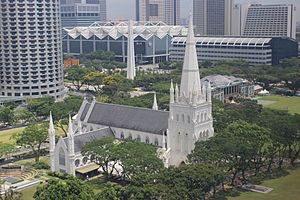Ronald MacPherson facts for kids
Quick facts for kids
Ronald MacPherson
|
|
|---|---|
 |
|
| 1st Colonial Secretary of Straits Settlements | |
| In office 1 April 1867 – 6 December 1869 |
|
| Preceded by | Position established |
| Succeeded by | James Wheeler Woodford Birch |
| 6th Resident Councillor of Singapore | |
| In office 8 October 1860 – 31 March 1867 |
|
| Preceded by | Henry Somerset MacKenzie |
| Succeeded by | Position abolished |
| Personal details | |
| Born | 14 July 1817 Island of Skye, Scotland |
| Died | 6 December 1869 (aged 52) Singapore |
| Resting place | Old Bukit Timah Cemetery |
| Nationality | British |
| Occupation | Colonial administrator, architect |
| Military service | |
| Years of service | 1854–1869 |
| Rank | Colonel |
| Unit | Singapore Volunteer Rifle Corps |
Ronald MacPherson (born July 14, 1817 – died December 6, 1869) was an important person in Singapore's history. He was a military officer, an architect, and a leader in the government. He is most famous for designing the beautiful St Andrew's Cathedral.
Contents
Early Life and Education
Ronald MacPherson was born on the Isle of Skye in Scotland. His family had roots in both Ireland and Scotland.
He went to a special military college called Addiscombe Military Seminary. This school was in Addiscombe, Croydon, and he studied there from 1834 to 1836.
MacPherson's Career
Ronald MacPherson had a varied career, working in the military and later in government.
Military Service
MacPherson wanted to join the Engineers Corps, which designs and builds things. However, there were not many openings.
Instead, he became a 2nd lieutenant in the Madras Artillery on June 10, 1836. He arrived in India later that year. In India, he learned Arabic and Hindustani. He also studied engineering and helped create important tables for artillery companies.
In 1842, MacPherson fought in the First Opium War with the Madras Artillery. The next year, he became a staff officer for the Artillery in the Straits Settlements.
Working for the Government
MacPherson began his government career in 1849 in Penang. He was an Executive Engineer and Superintendent of Convicts. This meant he oversaw building projects and managed prisoners who worked on them. He helped build important structures like the Police Office.
In 1854, MacPherson became the first Captain Commandant of the Singapore Volunteer Rifle Corps. This was a group of volunteers who helped protect Singapore. Later, in 1864, he became an Honorary Colonel for the same group.
From 1855 to 1857, he also worked in Singapore as an Executive Engineer and Superintendent of Convicts.
MacPherson became a Resident Councillor, a high-ranking government official. He served in Malacca in 1858, and then in Penang and Singapore starting in 1860.
In 1867, the British government made the Straits Settlements a separate Crown Colony. This happened because people living there wanted to be ruled directly by Britain, not by British India. MacPherson became the very first Colonial Secretary of the Straits Settlements. He held this important position until he passed away in 1869.
St Andrew's Cathedral
While MacPherson was an Executive Engineer, the Governor of Straits Settlement, William Butterworth, asked him to design a new church. This church was to be the St Andrew's Cathedral.
MacPherson designed it in the Gothic Revival style, which looks like old European cathedrals. Other people, like Major John F. A. McNair, helped finish the building in 1861.
Today, a special monument cross stands on the lawn of St Andrew's Cathedral. It is there to remember Ronald MacPherson and his contributions.
His Final Years
Ronald MacPherson died on December 6, 1869, in Singapore. He was buried at the Old Bukit Timah Cemetery there.
MacPherson's Legacy
To remember Ronald MacPherson and his work, a road in Singapore was renamed. Jalan Klapa is now known as MacPherson Road.


